Briggs & Stratton 20228, 195764GS User Manual
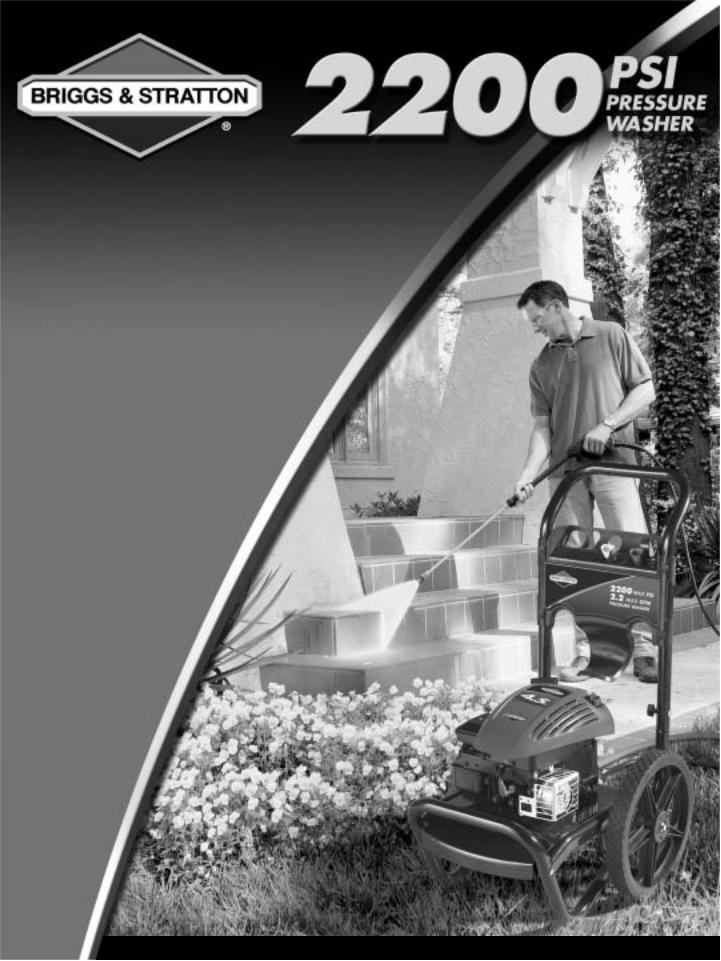
Owner’s Manual Manual del Propietario
Questions? Help is just a moment away!
Preguntas? La ayuda es justa un momento lejos!
Call: Pressure Washer Helpline
Llame: Línea Directa del Lavador a Presión 1-800-743-4115 M-F 8-5 CT
Web: www.briggsandstratton.com
Model No. 020228 Manual No. 195764GS Rev. 2 (01/19/2005)

Section |
Safety Rules |
|
1
SAVE THESE INSTRUCTIONS
TABLE OF CONTENTS
Section 1 - Safety Rules . . . . . . . . . . . . . . . . . . . . . . . . . . 2-4
Section 2 - Features and Controls . . . . . . . . . . . . . . . . . . . 5
Section 3 - Assembly . . . . . . . . . . . . . . . . . . . . . . . . . . . . 6-8
Section 4 - Operation . . . . . . . . . . . . . . . . . . . . . . . . . . 9-13
Section 5 - Product Specifications. . . . . . . . . . . . . . . . . . . 14
Section 5 - Maintenance. . . . . . . . . . . . . . . . . . . . . . . . 14-16
Section 6 - Storage . . . . . . . . . . . . . . . . . . . . . . . . . . . . . . 17
Section 7 - Troubleshooting. . . . . . . . . . . . . . . . . . . . . . . . 18
Warranty . . . . . . . . . . . . . . . . . . . . . . . . . . . . . . . . . . . . . . 19
EQUIPMENT
DESCRIPTION
Read this manual carefully and become familiar with your pressure washer. Know its applications, its limitations and any hazards involved.
This manual contains information for a pressure washer that operates up to a maximum of 2,200 PSI and at a maximum flow rate of 2.2 gallons per minute.This high quality residential system features 14” wheels, axial cam pump with stainless steel pistons, automatic cool down system, chemical injection system, and a variety of nozzle sizes.Also includes safety goggles, heavy duty 25’ hose, and more.
Every effort has been made to ensure that information in this manual is accurate and current. However, we reserve the right to change, alter or otherwise improve the product and this document at any time without prior notice.
SAFETY RULES
This is the safety alert symbol. It is used to alert you to potential personal injury hazards. Obey all safety messages that follow this symbol to avoid possible injury or death.
The safety alert symbol ( ) is used with a signal word (DANGER, CAUTION,WARNING), a pictorial and/or a safety message to alert you to hazards. DANGER indicates a hazard which, if not avoided, will result in death or serious injury. WARNING indicates a hazard which, if not avoided, could result in death or serious injury. CAUTION indicates a hazard which, if not avoided, might result in minor or moderate injury. CAUTION, when used without the alert symbol, indicates a situation that could result in equipment damage. Follow safety messages to avoid or reduce the risk of injury or death.
) is used with a signal word (DANGER, CAUTION,WARNING), a pictorial and/or a safety message to alert you to hazards. DANGER indicates a hazard which, if not avoided, will result in death or serious injury. WARNING indicates a hazard which, if not avoided, could result in death or serious injury. CAUTION indicates a hazard which, if not avoided, might result in minor or moderate injury. CAUTION, when used without the alert symbol, indicates a situation that could result in equipment damage. Follow safety messages to avoid or reduce the risk of injury or death.
 WARNING
WARNING
The engine exhaust from this product contains chemicals known to the State of California to cause cancer, birth defects, or other reproductive harm.
Hazard Symbols and Meanings
Toxic Fumes |
Electrical Shock |
Slippery Surface |
Fall |
Fluid Injection |
Fire |
Explosion |
Hot Surface |
Moving Parts |
Flying Objects |
Kickback |
2
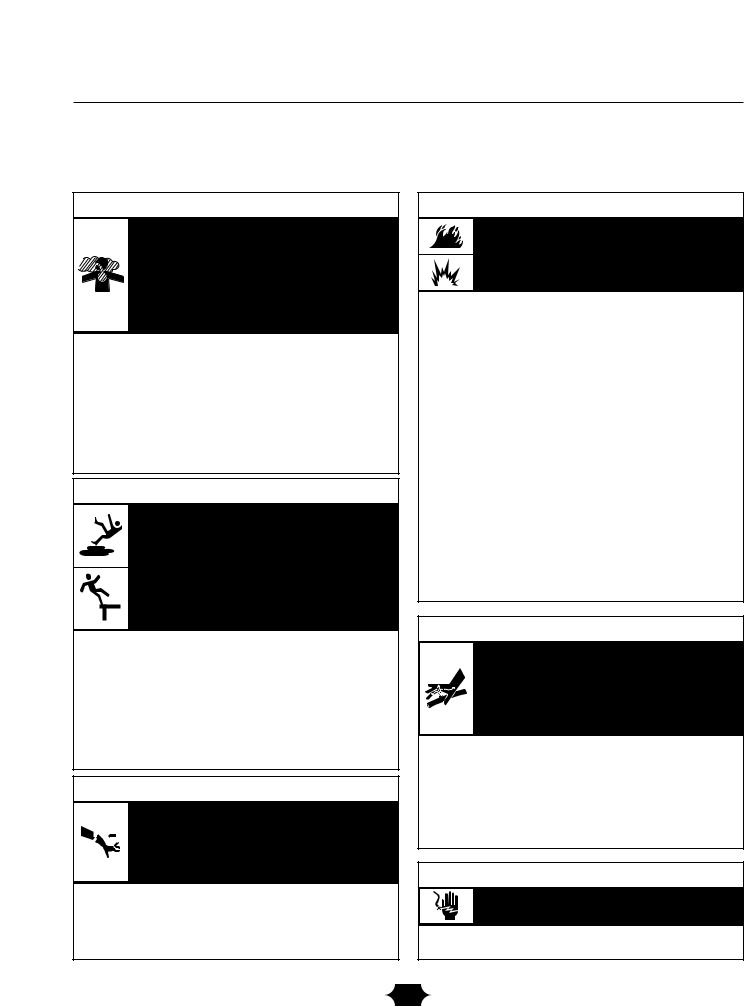
Section 1: Safety Rules
 WARNING
WARNING
Running engine gives off carbon monoxide, an odorless, colorless, poison gas.
Breathing carbon monoxide will cause nausea, fainting or death.
Some chemicals or detergents may be harmful if inhaled or ingested, causing severe nausea, fainting or poisoning.
•Operate pressure washer ONLY outdoors.
•Keep exhaust gas from entering a confined area through windows, doors, ventilation intakes or other openings.
•DO NOT operate pressure washer inside any building or enclosure.
•Use a respirator or mask whenever there is a chance that vapors may be inhaled.
•Read all instructions with mask so you are certain the mask will provide the necessary protection against inhaling harmful vapors.
 WARNING
WARNING
Use of pressure washer can create puddles and slippery surfaces.
High pressure spray could cause you to fall if you are too close to the cleaning surface.
•Keep spray nozzle between 8 to 24 inches away from cleaning surface.
•Operate this unit on a stable surface.
•The cleaning area should have adequate slopes and drainage to reduce the possibility of a fall due to slippery surfaces.
•Be extremely careful if you must use the pressure washer from a ladder, scaffolding or any other relatively unstable location.
•Firmly grasp spray gun with both hands when using high pressure spray to avoid injury if gun kicks back.
 WARNING
WARNING
Rapid retraction of starter cord (kickback) will pull hand and arm toward engine faster than you can let go.
Broken bones, fractures, bruises or sprains could result.
•When starting engine, pull cord slowly until resistance is felt and then pull rapidly to avoid kickback.
•If engine starts and fails to continue to run or if increased resistance is felt during starting pull attempts, squeeze trigger on spray gun.
 WARNING
WARNING
Fuel and its vapors are extremely flammable an explosive.
Fire or explosion can cause severe burns or death.
WHEN ADDING FUEL
•Turn pressure washer OFF and let it cool at least 2 minutes before removing gas cap.
•Fill fuel tank outdoors.
•DO NOT overfill tank.Allow space for fuel expansion.
•Keep fuel away from sparks, open flames, pilot lights, heat, and other ignition sources.
•DO NOT light a cigarette or smoke.
WHEN OPERATING EQUIPMENT
•DO NOT tip engine or equipment at angle which causes fuel to spill.
•DO NOT spray flammable liquids.
WHEN TRANSPORTING OR REPAIRING EQUIPMENT
•Transport/repair with fuel tank EMPTY or with fuel shutoff valve OFF.
WHEN STORING FUEL OR EQUIPMENT WITH FUEL IN TANK
•Store away from furnaces, stoves, water heaters, clothes dryers or other appliances that have pilot light or other ignition source because they can ignite fuel vapors.
 WARNING
WARNING
The high pressure stream of water that this equipment produces can pierce skin and its underlying tissues, leading to serious injury and possible amputation.
Spray gun retains high pressure when pressure washer is shut down, which can cause injury.
•NEVER aim spray gun at people, animals or plants.
•DO NOT allow CHILDREN to operate pressure washer.
•NEVER repair high pressure hose. Replace it.
•Keep high pressure hose connected to pump and spray gun while system is pressurized.
•Squeeze trigger on spray gun to relieve trapped pressure, every time you stop engine. Engage trigger lock on spray gun.
 WARNING
WARNING
Spray contact with electrical wiring can result in electrocution.
•Keep water spray away from electric wiring or fatal electric shock may result.
3
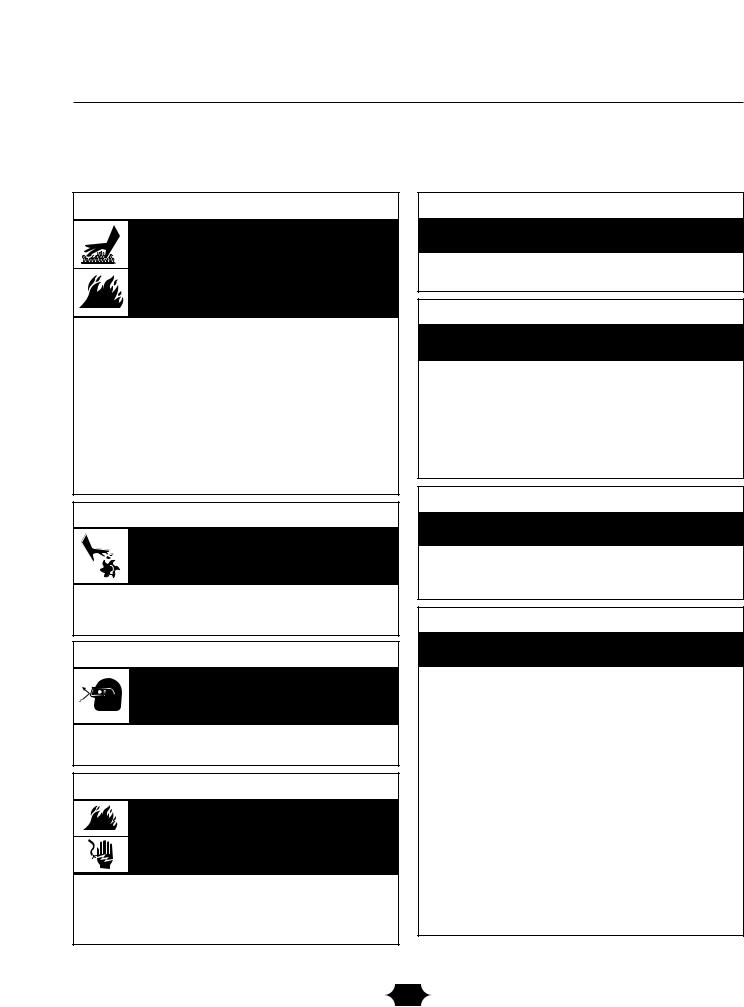
Section 1: Safety Rules
 WARNING
WARNING
Running engines produce heat.Temperature of muffler and nearby areas can reach or exceed 150°F (65°C).
Severe burns can occur on contact.
Combustible debris, such as leaves, grass, brush, etc. can catch fire.
•DO NOT touch hot surfaces.
•Allow equipment to cool before touching.
•The pressure washer must be at least 5 feet from structures having combustible walls and/or other combustible materials.
•Keep at least 3 feet of clearance on all sides of pressure washer for adequate cooling, maintenance and servicing.
•In the State of California a spark arrester is required by law (Section 4442 of the California Public Resources Code). Other states may have similar laws. Federal laws apply on federal lands. If you equip the muffler with a spark arrester, it must be maintained in effective working order.
 WARNING
WARNING
Starter and other rotating parts can entangle hands, hair, clothing, or accessories.
•DO NOT wear loose clothing, jewelry or anything that may be caught in the starter or other rotating parts.
•Tie up long hair and remove jewelry.
 WARNING
WARNING
High pressure spray can cause paint chips or other particles to become airborne.
•Always wear eye protection when using this equipment or in vicinity of where equipment is in use.
 WARNING
WARNING
Unintentional sparking can result in fire or electric shock.
WHEN ADJUSTING OR MAKING REPAIRS TO YOUR PRESSURE WASHER
•Disconnect spark plug wire from spark plug and place wire where it cannot contact spark plug.
 CAUTION
CAUTION
Excessively high or low operating speeds increase risk of injury and damage to pressure washer.
•DO NOT tamper with governed speed.
•DO NOT operate pressure washer above rated pressure.
 CAUTION
CAUTION
A pressure washer produces a high pressure spray which increases risk of injury and damage to unit.
•DO NOT secure spray gun in open position.
•DO NOT leave spray gun unattended while machine is running.
•NEVER use a spray gun which does not have a trigger lock or trigger guard in place and in working order.
•Always be certain spray gun, nozzles and accessories are correctly attached.
CAUTION
High pressure spray may damage fragile items including glass.
•DO NOT point spray gun at glass when using MAX (pin point) nozzle.
•NEVER aim spray gun at plants.
CAUTION
Improper treatment of pressure washer can damage it and shorten its life.
•If you have questions about intended use, ask dealer or contact Briggs & Stratton Power Products.
•NEVER operate units with broken or missing parts, or without protective housing or covers.
•DO NOT by–pass any safety device on this machine.
•Before starting pressure washer in cold weather, check all parts of the equipment to be sure ice has not formed there.
•NEVER move machine by pulling on high pressure hose. Use handle provided on unit.
•Check fuel system for leaks or signs of deterioration, such as chafed or spongy hose, loose or missing clamps, or damaged tank or cap. Correct all defects before operating pressure washer.
•This equipment is designed to be used with Briggs & Stratton Power Products authorized parts ONLY. If equipment is used with parts that DO NOT comply with minimum specifications, user assumes all risks and liabilities.
4
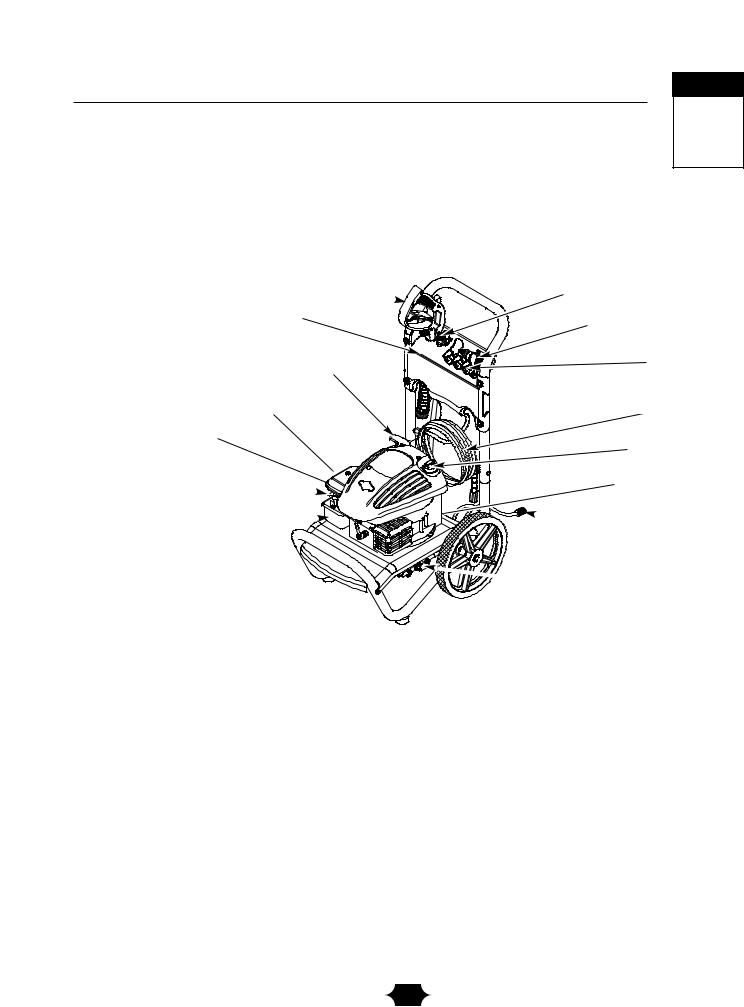
Features and Controls Section
2
KNOW YOUR PRESSURE WASHER
Read this owner’s manual and safety rules before operating your pressure washer.
Compare the illustrations with your pressure washer to familiarize yourself with the locations of various controls and adjustments. Save this manual for future reference.
Spray Gun 
Accessory Tray
Recoil Starter
Air Filter
Primer Bulb
Throttle Lever

Fuel Tank
Accessory Tray — Provides convenient storage for standard and optional accessories, such as brushes, turbo wands, etc.
Air Filter — Protects engine by filtering dust and debris out of intake air.
Automatic Cool Down System — Cycles water through pump when water reaches 125°-155°F.Warm water will discharge from pump onto ground.This system prevents internal pump damage.
Chemical Injection Siphon/Filter — Use to siphon detergent or other pressure washer chemicals into the low pressure stream.
Data Tag (not shown, near rear of base plate) –
Provides model and serial number of pressure washer. Please have these readily available if calling for assistance.
Fuel Tank — Fill tank with regular unleaded fuel. Always leave room for fuel expansion.
High Pressure Hose — Connect one end to water pump and the other end to spray gun.
Nozzle Extension with Quick Connect
Turbo Nozzle
ProjectPro™
Nozzles
High Pressure Hose
Oil Fill/Dipstick
High Pressure Outlet
& Water Inlet
 Chemical Injection
Chemical Injection
Siphon/Filter
 Pump equipped with Automatic Cool Down System
Pump equipped with Automatic Cool Down System
High Pressure Outlet — Connection for high pressure hose.
Nozzle Extension with Quick Connect — Allows you to switch between four different nozzles.
Oil Fill/Dipstick — Check and fill with oil here.
Primer Bulb — Prepares a cold engine for starting.
Pump — Develops high pressure.
Recoil Starter — Used for starting the engine manually.
Spray Gun — Controls the application of water onto cleaning surface with trigger device. Includes trigger lock.
ProjectPro™ Nozzles — Detergent, Max, General, and Delicate nozzles: for various pressure cleaning applications.
Throttle Lever — Sets engine in starting mode for recoil starter and stops a running engine.
Turbo Nozzle — Rotates a high pressure stream in a rapid circular pattern.
Water Inlet — Connection for garden hose.
5
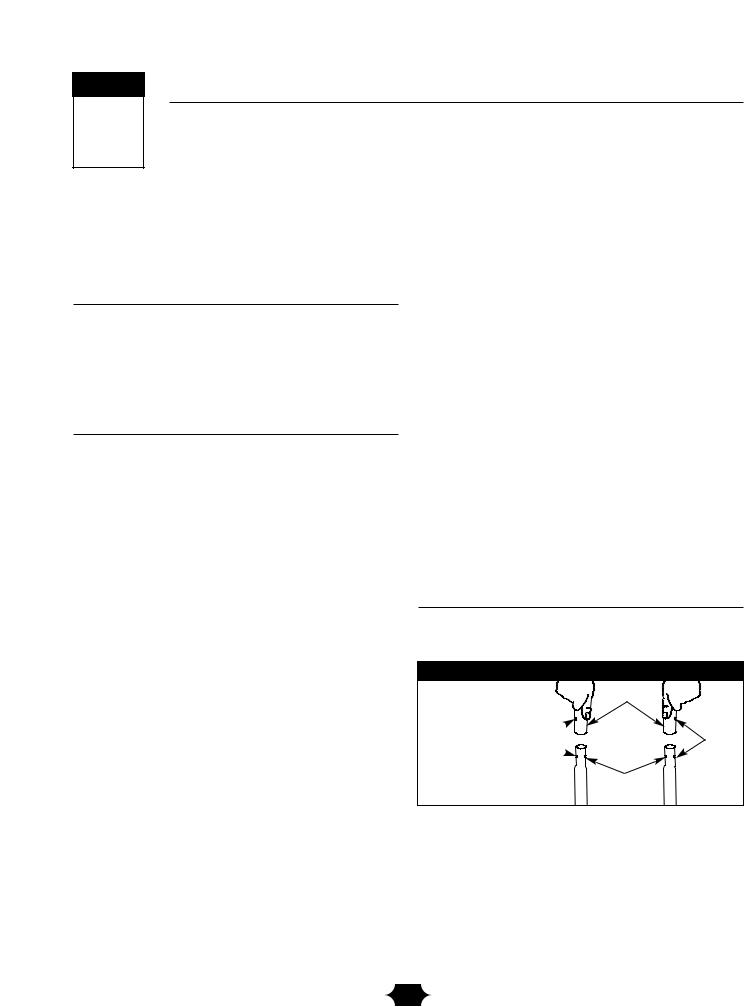
Section Assembly
3
ASSEMBLY
IMPORTANT: Read entire owner’s manual before you attempt to assemble or operate your new pressure washer.
Remove Pressure Washer From
Carton
1.Remove the parts bag, accessories, and inserts included with pressure washer.
2.Slice two corners at the end of carton from top to bottom so the panel can be folded down flat.
3.Remove pressure washer from carton.
Carton Contents
Items in the carton include:
•Main Unit
•Handle
•High Pressure Hose
•Spray Gun
•Nozzle Extension with Quick Connect Fitting
•Plastic Accessory Tray
•Safety Goggles
•Oil Bottle
•Turbo Nozzle with Quick Connect
•Parts Bag (which includes the following):
•Owner’s Manual
•Engine Manual
•Owner’s Registration Card
•Bag containing 4 multi–colored ProjectPro™ Nozzles
•Handle/Tray Fastening Hardware Kit (which includes):
•Carriage Bolts (2)
•Plastic Knobs (2)
•Tree Clips (4)
PREPARING PRESSURE WASHER FOR USE
If you have any problems with the assembly of your pressure washer or if parts are missing or damaged, call the pressure washer helpline at 1-800-743-4115. If calling for assistance, please have the model, revision, and serial number from the data tag available.
To prepare your pressure washer for operation, you will need to perform these tasks:
1.Fill out and send in registration card.
2.Attach handle to main unit, then attach accessory tray to handle.
3.Add oil to engine crankcase.
4.Add fuel to fuel tank.
5.Connect high pressure hose to spray gun and pump.
6.Connect water supply to pump.
7.Attach nozzle extension to spray gun.
8.Select/attach quick connect ProjectPro™ nozzle to nozzle extension.
Attach Handle and Accessory Tray
1.Place handle onto handle supports connected to main unit. Make sure holes in handle align with holes on handle supports (Figure 1).
Figure 1 — Attach Handle to Base
Handle
Align Holes
Handle
Supports
NOTE: It may be necessary to move the handle supports from side to side in order to align the handle so it will slide over the handle supports.
6

Section 3: Assembly
2.Insert carriage bolts through holes from outside of unit and attach a plastic knob from inside of unit (Figure 2). Tighten by hand.
Figure 2 — Secure Handle
3.Place accessory tray over holes on handle (viewing from front of unit). Push the tree clips into the holes until they sit flat against the accessory tray (Figure 3).
Figure 3 — Attach Accessory Tray to Handle |
4.Insert multi–colored ProjectPro™ nozzles and other supplied accessories in spaces provided in accessory tray. See “How to Use Accessory Tray”.
Add Engine Oil and Fuel
• Place pressure washer on a level surface.
CAUTION
Any attempt to crank or start the engine before it has been properly filled with the recommended oil will result in equipment failure.
•Refer to engine manual for oil and fuel fill information.
•Damage to equipment resulting from failure to follow this instruction will void warranty.
•Refer to engine owner’s manual and follow oil and fuel recommendations and instructions.
NOTE: Check oil often during engine break–in. Refer to engine owner’s manual for recommendations.
7

Section 3: Assembly
Connect Hose and Water Supply to Pump
IMPORTANT: To avoid pump damage, you must assemble the nozzle extension to the spray gun and attach all hoses before you start the engine.
NOTE: Remove and discard the shipping caps from the pumps high pressure outlet and water inlet before attaching hoses.
1.Uncoil high pressure hose and attach one end of hose to base of spray gun (Figure 4).Tighten by hand.
Figure 4 — Connect High Pressure Hose to Spray Gun
Connect high pressure hose here
2.Attach other end of high pressure hose to high pressure outlet on pump (Figure 5).Tighten by hand.
Figure 5 — Connect High Pressure Hose to Pump
3.Before connecting garden hose to water inlet, inspect inlet screen (Figure 6). Clean screen if it contains debris or have it replaced if damaged. DO NOT RUN PRESSURE WASHER IF INLET SCREEN IS DAMAGED.
Figure 6 — Connect the Garden Hose to Water Inlet
Inspect inlet screen, DO NOT use if damaged; clean if dirty.
4.Run water through your garden hose for 30 seconds to clean out any debris.
IMPORTANT: DO NOT siphon standing water for the water supply. Use ONLY cold water (less than 100°F).
5.Connect the garden hose (not to exceed 50 feet in length) to the water inlet.Tighten by hand (Figure 6).
CAUTION
There MUST be at least ten feet of unrestricted garden hose between the pressure washer inlet and any flow shut off device, such as a ‘Y’ shut-off connector or other convenience-type water shut-off valve.
•Damage to equipment resulting from failure to follow this instruction will void warranty.
6.Turn ON the water and squeeze the trigger on the gun to purge the pump system of air and impurities.
 WARNING
WARNING
High pressure spray can cause paint chips or other particles to become airborne.
•Always wear eye protection when using this equipment or in vicinity of where equipment is in use.
•Before starting the pressure washer, be sure you are wearing adequate eye protection.
Checklist Before Starting Engine
Review the unit’s assembly to ensure you have performed all of the following.
1.Make sure handle is in place and secure.
2.Check that oil has been added to proper level in the engine crankcase.
3.Add proper gasoline to fuel tank.
4.Check for properly tightened hose connections.
5.Check to make sure there are no kinks, cuts, or damage to high pressure hose.
6.Provide a proper water supply at an adequate flow.
7.Be sure to read “Safety Rules” and “How To Use Your Pressure Washer” before using pressure washer.
8
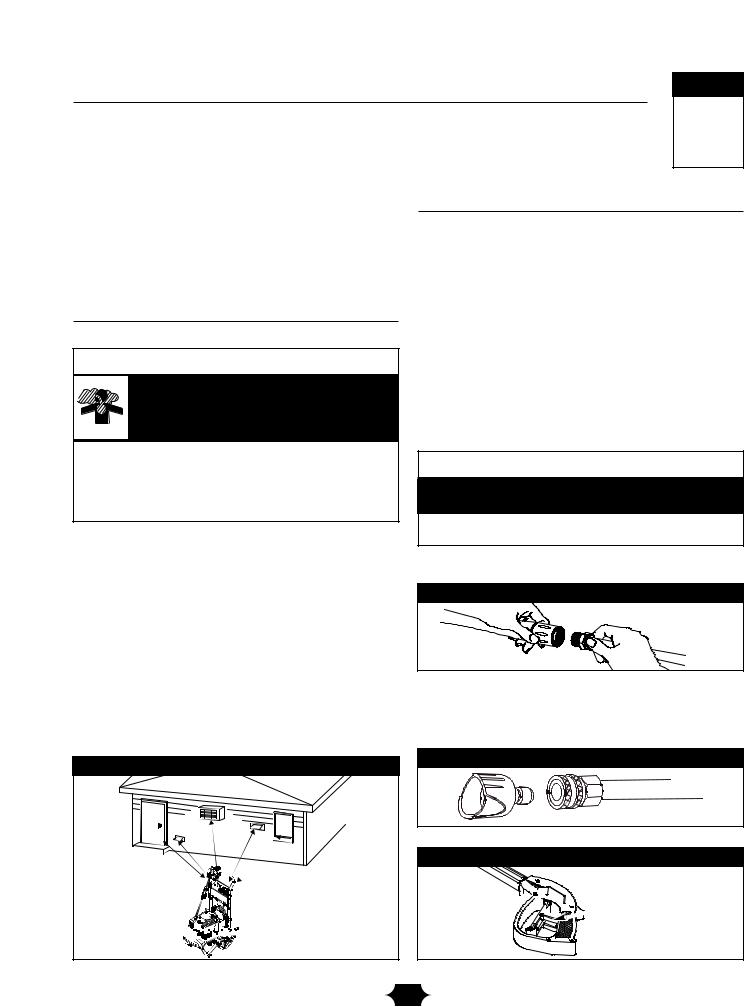
Operation Section
4
HOW TO USE YOUR PRESSURE WASHER
If you have any problems operating your pressure washer, please call the pressure washer helpline at 1-800-743-4115.
Pressure Washer Location
Pressure Washer Clearance
 WARNING
WARNING
Running engine gives off carbon monoxide, an odorless, colorless, poison gas.
Breathing carbon monoxide will cause nausea, fainting or death.
•Operate pressure washer ONLY outdoors.
•Keep exhaust gas from entering a confined area through windows, doors, ventilation intakes or other openings.
•DO NOT operate pressure washer inside any building or enclosure.
The pressure washer must be at least 5 ft. (152 cm) from structures having combustible walls and/or other combustible materials. Leave at least 3 ft. (92 cm) all around pressure washer including overhead, for adequate cooling, maintenance and servicing.
Place pressure washer in a well ventilated area, which will allow for removal of deadly exhaust gas. DO NOT place pressure washer where exhaust gas could accumulate and enter inside or be drawn into a potentially occupied building. Ensure exhaust gas is kept away from any windows, doors, ventilation intakes or other openings that can allow exhaust gas to collect in a confined area
(Figure 7). Prevailing winds and air currents should be taken into consideration when positioning pressure washer.
Figure 7 — Pressure Washer Clearance
Typical Pressure
Washer Shown













 Exhaust Port
Exhaust Port
How to Start Your Pressure Washer
To start your pressure washer for the first time, follow these instructions step-by-step.This starting information also applies if you have let the pressure washer sit idle for at least a day.
1.Place pressure washer near an outside water source capable of supplying water at a flow rate greater than 3.2 gallons per minute and no less than 20 PSI at pressure washer end of garden hose.
2.Check that high pressure hose is tightly connected to spray gun and pump. See “Preparing Pressure Washer for Use” for illustrations.
3.Make sure unit is in a level position.
4.Connect garden hose to water inlet on pressure washer pump. Turn ON water.
CAUTION
DO NOT run the pump without the water supply connected and turned on.
•Damage to equipment resulting from failure to follow this instruction will void warranty.
5.Attach nozzle extension to spray gun (Figure 8). Tighten by hand.
Figure 8 — Connect Nozzle Extension to Spray Gun
6.Choose ProjectPro™ nozzle you want to use, pull back on collar of nozzle extension, insert nozzle and release collar.Tug on nozzle to make sure it is securely in place (Figure 9). See “How to Use ProjectPro™ Nozzle System”.
Figure 9 - Attaching ProjectPro™ Nozzle to Nozzle Extension
7.Engage trigger lock on spray gun trigger (Figure 10).
Figure 10 — Spray Gun with Trigger Lock Engaged

 Trigger Lock
Trigger Lock
9
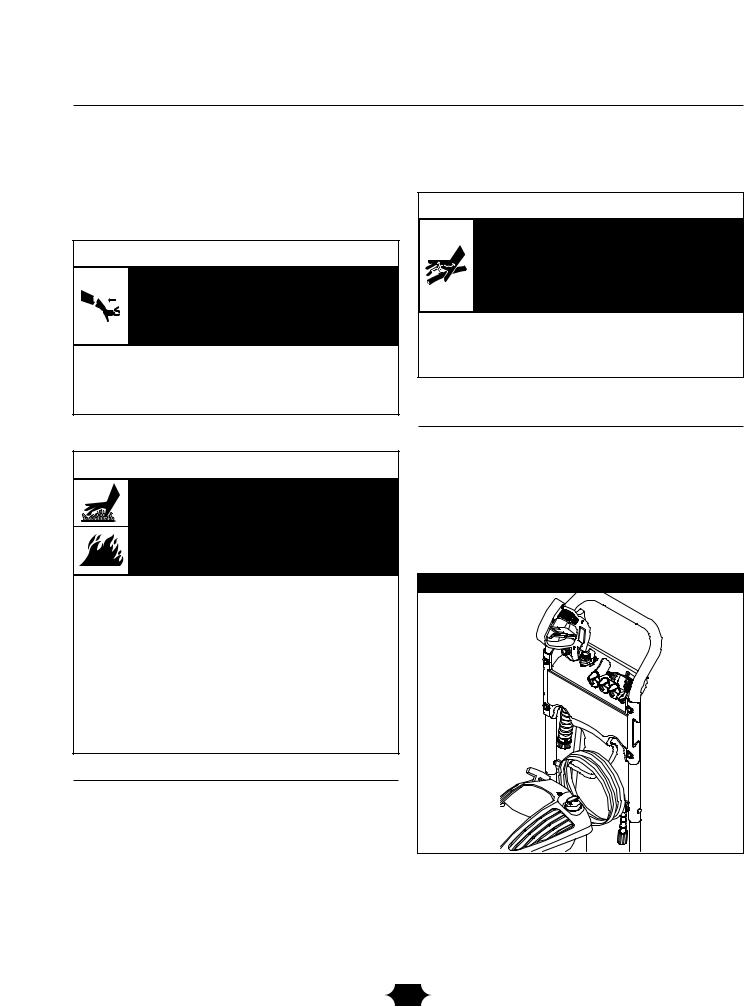
Section 4: Operation
8.Start engine according to instructions given in engine owner’s manual. Also see operating instructions tag located on the pressure washer.
 WARNING
WARNING
Rapid retraction of starter cord (kickback) will pull hand and arm toward engine faster than you can let go.
Broken bones, fractures, bruises or sprains could result.
•When starting engine, pull cord slowly until resistance is felt and then pull rapidly to avoid kickback.
•If engine starts and fails to continue to run or if increased resistance is felt during starting pull attempts, squeeze trigger on spray gun.
NOTE: Always keep the throttle lever in the “Fast” position when operating the pressure washer.
 WARNING
WARNING
Running engines produce heat.Temperature of muffler and nearby areas can reach or exceed 150°F (65°C).
Severe burns can occur on contact.
Combustible debris, such as leaves, grass, brush, etc. can catch fire.
•DO NOT touch hot surfaces.
•Allow equipment to cool before touching.
•The pressure washer must be at least 5 feet from structures having combustible walls and/or other combustible materials.
•Keep at least 3 feet of clearance on all sides of pressure washer for adequate cooling, maintenance and servicing.
•In the State of California a spark arrester is required by law (Section 4442 of the California Public Resources Code). Other states may have similar laws. Federal laws apply on federal lands. If you equip the muffler with a spark arrester, it must be maintained in effective working order.
How to Stop Your Pressure Washer
1.Let engine idle for two minutes.
2.Turn engine off according to instructions given in engine owner’s manual.
3.Squeeze trigger on spray gun to relieve trapped pressure in hose to avoid injury.
NOTE: A small amount of water will squirt out when pressure is released.
 WARNING
WARNING
The high pressure stream of water that this equipment produces can pierce skin and its underlying tissues, leading to serious injury and possible amputation.
Spray gun retains high pressure when pressure washer is shut down, which can cause injury.
•Keep high pressure hose connected to pump and spray gun while system is pressurized.
•Squeeze trigger on spray gun to relieve trapped pressure, every time you stop engine. Engage trigger lock on spray gun.
4.Engage trigger lock on spray gun when not in use.
How to Use Accessory Tray
The unit is equipped with an accessory tray with places to store your spray gun, nozzle extension, turbo nozzle, and ProjectPro™ nozzles.There is also a hook at the front of the accessory tray to hold your high pressure hose.
NOTE: The extra hole in the tray is for storing a utility brush.The brush is NOT included with your pressure washer.You can buy the brush as an optional accessory.
1.Place nozzle extension through hole on accessory tray, as shown in Figure 11.
Figure 11 — Typical Accessory Tray
2.Place spray gun through hole on accessory tray on right side of unit (Figure 11).
3.Push turbo nozzle up and into clip on accessory tray until it snaps in, as shown in Figure 11.
4.Hang high pressure hose on hook attached to accessory tray on front of tray, as shown in Figure 11.
10
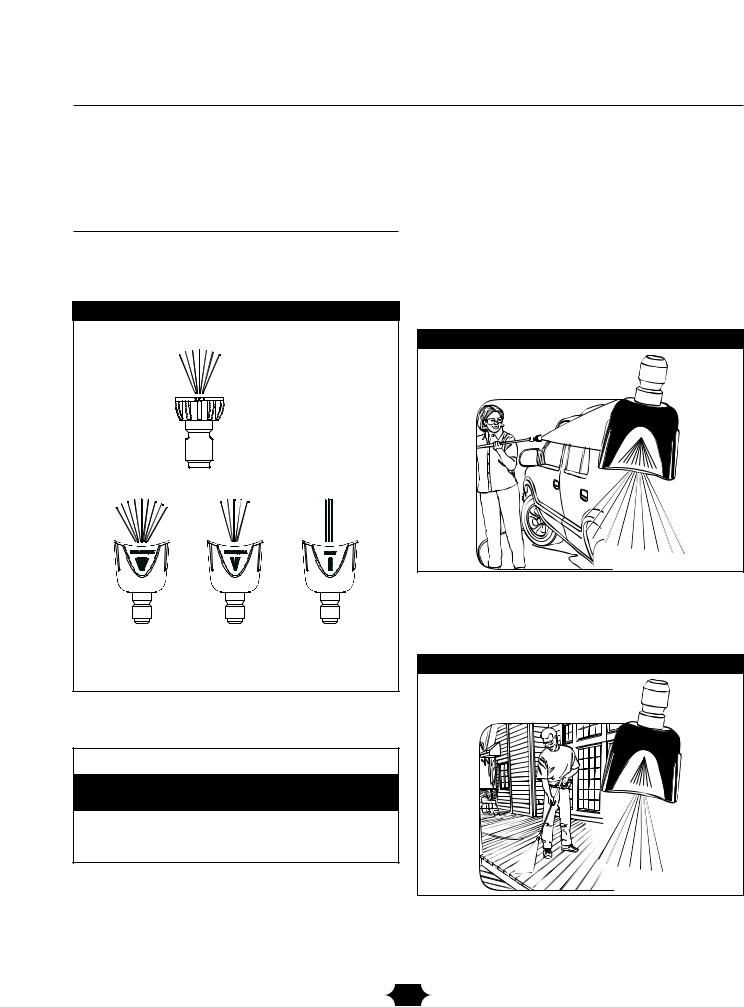
Section 4: Operation
How to Use ProjectPro™ Nozzle System
The quick–connect on the nozzle extension allows you to switch between four different ProjectPro™ system nozzles. The ProjectPro™ nozzles vary the pressure and spray pattern as shown (Figure 12).
Figure 12 — Nozzle Spray Patterns
Low Pressure
Black
Use to apply detergent
High Pressure
Delicate |
|
General |
|
Max |
40° Yellow |
|
15° Orange |
|
0° Red |
1650 PSI |
|
1950 PSI |
|
2200 PSI |
2.2 GPM |
|
2.1 GPM |
|
1.9 GPM |
Follow these instructions to change ProjectPro™ nozzles:
1.Engage trigger lock on spray gun.
 CAUTION
CAUTION
A pressure washer produces a high pressure spray which increases risk of injury and damage to unit.
•NEVER exchange ProjectPro™ nozzles without locking the trigger lock on the trigger.
•DO NOT twist ProjectPro™ nozzles while spraying.
2.Pull back collar on quick–connect and pull current ProjectPro™ nozzles off. Store ProjectPro™ nozzles in holder provided on the accessory tray.
3.Select desired ProjectPro™ nozzle:
•For delicate rinse (lower pressure and higher flow), for gentle cleaning of cars/trucks, boats, RV’s, patio furniture, lawn equipment, etc., select yellow Delicate ProjectPro™ nozzle (Figure 13).
Figure 13 — Delicate Nozzle
•For general rinsing (medium pressure and medium flow), ideal for most all purpose cleaning such as home siding, brick patios, wood decks, driveways and sidewalks, garage floors, etc., select orange General ProjectPro™ nozzle (Figure 14).
Figure 14 — General Nozzle
11
